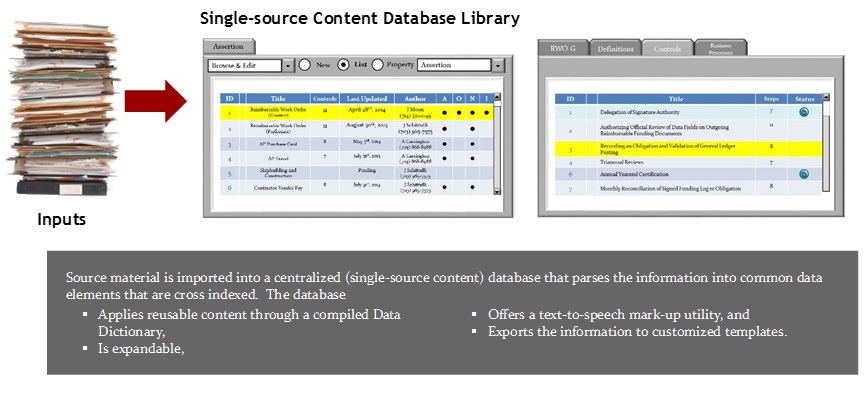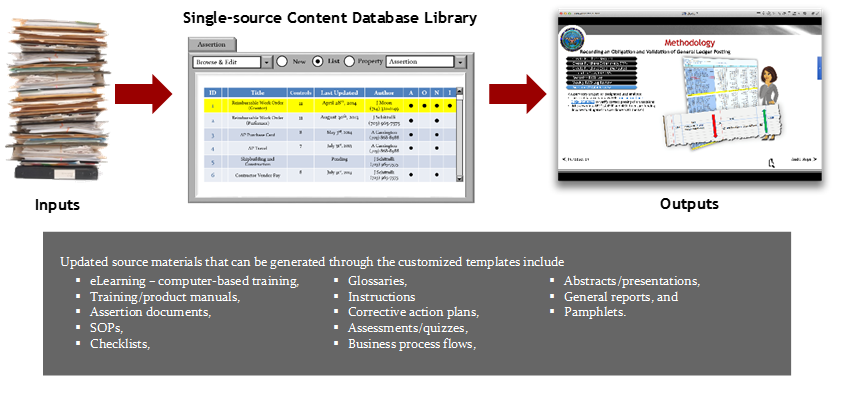Technology
Canterbury’s technology links large volumes of content from multiple documents in one database so that the information can be republished in various customized templates without having to update each document individually.
Our clients are typically trying to manage a large quantity of information that requires frequent updates. Making these updates to the myriad documents they affect is generally time consuming and prone to errors and inconsistencies. The risk associated with maintaining deliverables over their applicable life spans increases exponentially based on the number of documents involved and the number of personnel working on the project. Furthermore, some material requires annual updates based on changes to policy and regulations. Canterbury Resources’ experts can address your organization’s immediate needs by managing large volumes of data/information, enabling more effective information sharing and reporting, increasing operational efficiencies, eliminating redundancies, and facilitating compliance to laws, regulations and policies.
Our team manages vast quantities of information through our internally developed content management and productivity tools, which we refer to as the Canterbury Enterprise Content Management and Learning System (CECMLS). While we refer to this as a system, it is in fact a framework that “glues” Microsoft-specific applications, such as Access and SharePoint, into a workflow for authoring, managing, re-structuring and publishing content. We developed a variety of complex macros to restructure and manage the content, including automated import, transformation and export utilities. Using these tools, data is extracted from the source material, indexed for reference and added to a database library. This process is relatively quick, though it varies based on the size and complexity of the documents.
The CECMLSTM is designed to enhance, update, trace and re-purpose large procedural/policy documents more efficiently and cost effectively by linking the content from a structured configuration and version-controlled database into various customized template formats (e.g., eLearning material, procedural documents, checklists, and executive abstracts/ presentations). Using the CECMLS, we are able to centralize data, identify common elements (e.g., glossary definitions, figures, detailed narrative, graphics, references, and tables) and link these into templates that ultimately represent your necessary deliverables such as business/financial assertion documents, corrective action plans, control checklists, reference sheets and eLearning material. Once you have selected a template, the information can be exported with the click of a mouse. The same data can be exported into multiple templates, and the templates themselves can be customized to your specifications.
For a fraction of what you currently pay to maintain or update your critical documentation, you can employ the CECMLSTM. The end result is significant cost savings and return on investment. Canterbury offers multiple, flexible delivery mechanisms, as listed below, that allow our clients to benefit from this innovative solution based on their individual requirements:
- Consulting services provided on a fixed-price or cost-type basis,
- Annual licensing fees, including maintenance and technical support, or
- A perpetual license and support as necessary.
A Canterbury Team completes the initial setup. Afterward, we can manage the data, or we can teach your subject matter expert (SME) or designated representative to make modifications through the database.
The efficient adaptation and creation of content for our clients is fundamental to our services strategy. Our proprietary technology allows us to more effectively and efficiently deliver our services by
- Managing the task content by building on our accomplishments to date and/or existing customer documentation;
- Rapidly addressing evolving changes, updates and iterations;
- Enhancing an organization’s existing learning management system (LMS), data repository and/or corporate document management system (CDMS);
- Moving closer to real-time publication of consistent and customized documentation and supporting materials;
- Improving communication and coordination among all key stakeholders involved in task support, e.g., department leadership, managers, contract workforce, service providers, auditors and financial managers;
- Providing various levels of mapping among the content components and the assembled documentation;
- Complementing and enhancing existing training and learning materials;
- Optimizing content reuse and maintaining control over the information’s integrity; and, finally,
- Supporting the effective use of resources by allowing work products to be updated and sustained easily in the future by the customer or an appointed designee.



